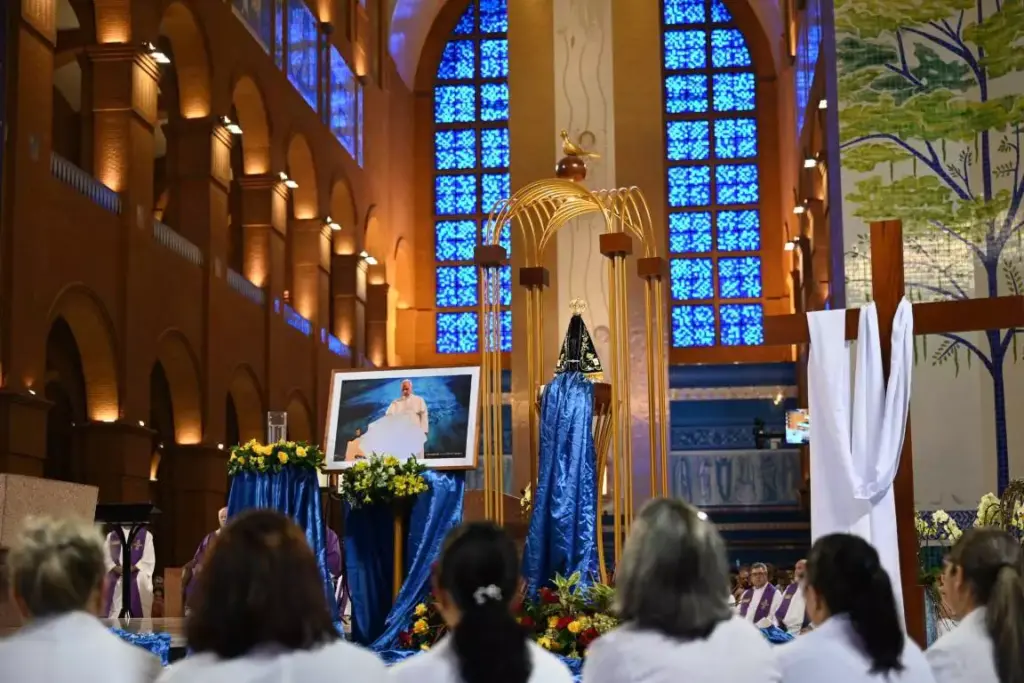
During the Holy Mass for the Dead last Sunday (2), at 8 am, at the National Shrine of Our Lady Aparecida, a profound symbolic gesture was made with the water originated from the melting of a glacial layer in Greenland, brought by two representatives of the Laudato Si’ Movement.
That gesture, inspired by encyclical Laudato Si’, by Pope Francis, was a sign of the urgent need to care for our Common Home, the Earth.
A Eucharistic celebration was presided over by Monsignor Orlando Brandes, Archbishop of Aparecida, and animated by Redemptorist missionary Brother Alan Patrick Zuccherato, C.Ss.R., Art and Pastoral Director of TV Aparecida broadcast.
In his homily, Archbishop Brandes addressed the topics of death, salvation, and resurrection, reminding everyone that although death is certain, in Christ it does not have the last word. “Believe in my love, I have risen, you will rise too”, he stated, echoing the words of the Gospel.
Beyond the reflection on human death, the archbishop also warned about the “death” of the Earth, a wound caused by environmental destruction and lack of care for the environment.
“We are killing our Mother Earth”, said Monsignor Brandes, calling everyone to reflect on “ecological sin” and the urgent need for an “ecological conversion”, an integral transformation that includes caring for creation as an expression of our faith.
Ecological conversion: A call to hope and Christian commitment
In an interview to channel A12, Eduardo Scorsatto, campaign coordinator for Laudato Si’ Movement Brazil, and Suzana Moreira, who works in operational and logistical support for the Movement, reflected on the meaning of this symbolic gesture and the impact of the message it conveys.
Eduardo Scorsatto: “Saint John of the Cross, in the twilight of his life, reminds us that we will be judged by love. This is the same call that Pope Francis made in Laudato Si’. The water from the melting snow which we brought from Rome, blessed by Pope Leo XIV, is not just a symbol, but a call to action, an urgent one. Each sacred place it visits strengthens the idea that caring for creation is an urgent form of prayer. We need a complete transformation to coexist with creation in a new way.”
Eduardo further explained that the water will travel through various shrines and be carried to COP 30, symbolizing the urgency of this transformation which is not only environmental, but also spiritual. “This gesture is a way for us to raise awareness of the whole of which we are a part. When we become more aware of this relationship, our actions become prayers”, he said.
Suzana Moreira: “This gesture has a profound spiritual meaning… As Pope Francis says in Laudato Si’, caring for creation is an expression of our love of God. The meltwater, brought from such a distant place, symbolizes the urgent need to care for the Earth, our Common Home. It is not just a natural element, but a spiritual invitation. By bringing it to the altar, especially in a moment of prayer for the deceased, we are reminded that our mission goes beyond the spiritual realm: we must care for creation with the same love we profess to God.”
The challenge of caring for our common home
The moment of welcoming the meltwater during the celebration was also a call to concrete action. As devotees of Our Lady Aparecida, we are called to live a more committed faith, reflected not only in words, but in attitudes.
Water symbolizes renewal, and this renewal must begin with our daily actions. Regarding creation, Suzana, speaking about the impact of this gesture, stated:
“By welcoming this water, not only does the Shrine welcome a message of hope, but one of urgency as well. We live in challenging times when the climate crisis demands a response from us. The gesture of bringing this water to the altar invites us to reflect on how we are treating our planet. Caring for creation is prayer, it is commitment to God and to the future.”
Monsignor Brantes also called on everyone to reflect on the impact of our actions on the environment, not just as a technical problem, but as a call to personal and communal conversion. The archbishop said in an interview to the Aparecida Communication Network:
“We are destroying things, but there is still time to sow hope, to praise God for the tenth anniversary of Pope Francis’ encyclical Laudato Si’… May this symbol be a shock, a call, a cry from Mother Earth and from the poorest so that we can rebuild this world, changing the desert into a garden”, he pointed out.





